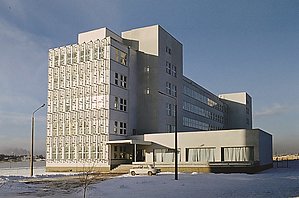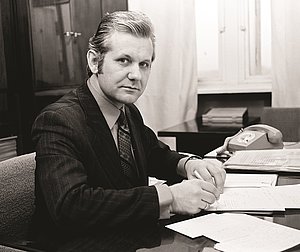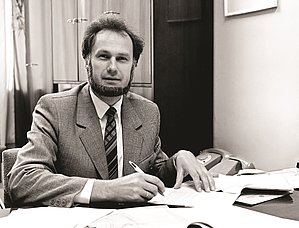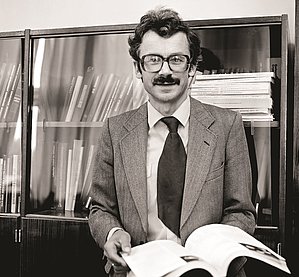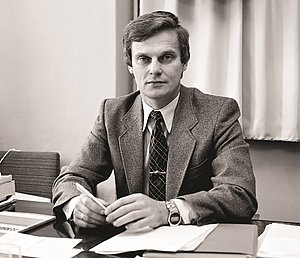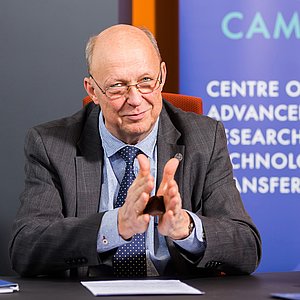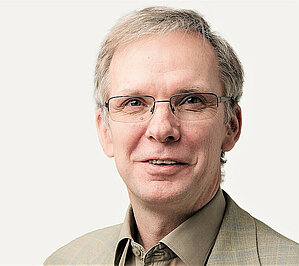History of Institute of Solid State Physics UL
After the Second World War, University of Latvia continued the research in the field of solid-state physics initiated by Doc. Ludvigs Jansons. In 1960, Ilmars Vitols established the Laboratory of Semiconductor Physics Problems, and in 1968 the Laboratory of Ferro- and Piezoelectric Physics Problems was formed by Voldemars Fricbergs. Initially both laboratories were located in the main building of the University of Latvia. As the number of scientific staff members and students was increasing, soon enough the premises became too small and more space was needed. It was proposed to build a separate building for both laboratories, as well as for the Semiconductor Physics Department. Thanks to the hard work and persistence of Ilmars Vitols and the main engineer Olgerts Abolins, in 1975 a dedicated facilities building, Educational and Scientific Complex, was constructed on the bank of river Daugava in Ķengarags, a neighborhood in Riga. This was the foundation for forming the Institute of Solid State Physics, University of Latvia (ISSP UL) in 1978. Juris Zakis was elected the first Director of the ISSP UL.
Research of ionic crystals, glassy materials, ferroelectric materials and fundamental research of amorphous semiconductors, as well as development of measuring equipment for automatization of solid-state physics experiments were the main work-streams of the ISSP UL at the time. According to these research areas the following departments with several laboratories were formed: Department of Ionic Crystal Physics (Head of the Department – Ivars Tale), Department of Glass Physics (Head of the Department – Andrejs Silins), Department of Ferroelectric Physics (Head of the Department – Voldemars Fricbergs), Department of Semiconductor Materials (Head of the Department – Andrejs Lusis). For the purposes of addressing the general issues of experiment automatization, the Laboratory of Programmed Experiment was formed (Head of the Laboratory – Jurijs Kuzmins), and the Division of Electronic Computing Machines was formed to address the management of programmed experiments and processing of results (Head of the Division – Imants Grikis). The following units were formed: Mechanical Workshops (Head of the Workshops – Olgerts Abolins), Design Division (Head of the Division – Janis Straumens), Electric Engineering Division (Head of the Division – Edmunds Tardenaks), Cryogenic Station (Head of the Station – Ilmars Dunkurs).
The research directions did not change much over time, and by the late 1980s, the ISSP UL had become one of the biggest and most prolific physics centers in Latvia and the USSR. Regular USSR, Baltic States and regional level conferences and workshops were organized by the ISSP UL, covering such topics as crystal physics, formation of defects in crystalline and glassy materials, ferroelectric materials, including transparent ferroelectric ceramics, solid-state ionics, automatization of experiments and development of training software.
In the beginning of 1990s, after the collapse of the USSR, the number of scientific and technical staff at ISSP UL dropped significantly, approximately from 290 to 150. Situation changed in 1993 when the ISSP UL was joined by approximately 20 members from 3 laboratories of the Institute of Physics of Latvian Academy of Sciences and by another 20 members from the Laboratory of Nuclear Reactions of the Institute of Physics in 1999. In 1992 the Laboratory of Optical Materials was established, and a new study program was formed – Optometry and Vision Science (Head of the Department – Ivars Lācis). In 2004, another laboratory joined the ISSP UL – the Laboratory of Organic Materials of the Institute of Physical Energetics of the Latvian Academy of Sciences (Head of the Laboratory – Inta Muzikante).
In 2001, Excellence Centre of Advanced Material Research and Technology (CAMART), a project developed by the ISSP UL, was granted funding in a competition organized by the European Commission (EC). The mission of the Centre was to promote research and disseminate knowledge of modern functional materials and high technologies with special emphasis on application in microelectronics and photonics. It was implemented by improving the links with other European centers and researchers through networking and twinning arrangements.
In 2000s, Latvian contribution to the European fusion program began. Since the establishment of the association EURATOM - University of Latvia in December 2001, the ISSP UL has taken a leading role in the implementation of an internationally significant project, becoming the coordinator of the Association's Latvian Research Unit consisting of ISSP UL, Institute of Physics UL, and the Institute of Chemical Physics UL. ISSP UL is also a part of the EUROfusion consortium agreement signed in 2014.
In 2003, the Chair of Solid State and Materials Physics was established at the Faculty of Physics and Mathematics of the University of Latvia, which is located on the premises of the Institute. Since 2009, the Institute hosts the Doctoral School Functional Materials and Nanotechnologies UL, where industry representatives, local and foreign scientists, and students themselves present current topics in the field of functional materials and nanotechnologies in Latvia and in the world.
Since 2005, the ISSP UL has been a coordinator of several National Research Programs in Materials Science and Information Technologies: ‘Development of advanced functional materials for microelectronics, nanoelectronics, photonics, biomedicine, and constructional composites, as well as related technologies’ (2005-2009), ‘Development of novel multifunctional materials, signal processing and information technologies for competitive knowledge-based products’ (2010-2013), ‘Multifunctional materials and composites, photonics and nanotechnology’ (2014-2017). The Institute is a partner organization in several more of the National Research Programs: ‘Trends, challenges and solutions of Latvian gas infrastructure development – LAGAS (2019-2021), ‘Top quark and Higgs physics at the CMS experiment, development of crystal scintillator detectors and sub-detectors of the CMS detector, and development of particle accelerator technologies for social applications in collaboration with CERN’ (2020-2022), and two of the ‘Mitigation of COVID-19 effects’ projects (2020).
In 2006, a conference on Functional Materials and Nanotechnologies (FM&NT) was organized by ISSP UL. Stated as a local conference, the conference expanded into an international event, annually attracting more than 250 participants not only from the countries of Baltic Sea region, but also from the rest of the EU, USA, Brazil, Norway, Russia, Ukraine, Belarus, Kazakhstan, Taiwan, Korea, Georgia, Turkey, and other countries. The diverse country list is an indication of the importance of the conference for scientists working in various fields. For 7 years, FM&NT was organized by the Institute of Solid State Physics, University of Latvia. In 2013, the event moved to Estonia, and was organized by the Institute of Physics, University of Tartu, then returned back to Riga in 2014, and in 2015 was organized by the Vilnius University. Selected speakers and a good balance between the topics of the conference ensure its growing popularity.
In 2008, the first Solar Cup competition was organized, in which the teams of school youth competed with solar-powered land, water, and air vehicle models. In 2015, a new tradition of internal scientific projects competition among young researchers as well as Master and PhD students was initiated.
In 2012, ISSP UL became a coordinator of ERDF project “National Research Centre of Nanostructured and Multifunctional Materials, Constructions and Technologies”. In the frame of the project, the infrastructure of ISSP UL has been substantially improved. In 2013 cleanroom facilities located at the premises of ISSP UL with total area ~650 m2 were built. Modern laser, Fourier spectroscopy equipment, X-ray diffractometer, photolithography and electron microscopy tools (SEM-TEM-FIB) were installed.
In 2014 ISSP UL participated in Teaming call within Horizon2020 program for funding to upgrade the existing Centre of Excellence into CAMART2 – Centre of Advanced Materials Research and Technology Transfer. In the competition of total 169 proposals, CAMART2 project was the third best proposal selected by EC for the preparation of the Business Plan for the upgrade of the Centre of Excellence. The EC named the 10 winners of 2nd phase of the WIDESPREAD 1-2014: Teaming on 23 November 2016. At the time, the ISSP UL was the only scientific institute in the Baltic Sea region and within a radius of 1,500 km that received EC support under the Horizon 2020 program “Spreading Excellence and Widening Participation”.
The upgrade enables efficient transfer of new materials and technologies into products for commercial and public benefits based on exchange of knowledge and synergy with innovation-intensive Consortium partners – KTH Royal Institute of Technology and Acreo Swedish ICT (during the project implementation, Acero became part of consortium of Research Institutes of Sweden - RISE). The implementation of the project relies on the partners' long-term experience in implementing innovations, as well as the experience of science and business cooperation accumulated in the Nordic Innovation Cluster Center - Kista Science City. The CAMART2 project combined the opportunities offered by all three partners to form a RIX – STO collaboration platform for regional research and technology transfer in order to enable development, research, and innovation. The EC provided € 15 million euros in funding for the development of CAMART2. This funding covers costs related to institutional development for a period of seven years (2016-2023). In addition to this amount, more than € 16 million euros from the EC Structural Funds, administered by the Ministry of Education and Science and the Ministry of Economics of Latvia, have been invested in the upgrade of the Institute’s scientific infrastructure. The Covid-19 and the related restrictions had a significant impact on the implementation of the project, therefore in December 2021 the EC prolonged CAMART2 implementation until 31 January 2025.
In 2017, the ISSP UL started extensive organizational and infrastructure upgrade, bringing to life the Institute's development strategy and the CAMART2 project goal - modernization of ISSP UL and establishing the ISSP UL as the most important center of excellence for education, science, innovation, and technology transfer in the Baltic States. The main infrastructure modernization works were completed in June 2021.
In order to promote the use of innovations created at the ISSP UL for the needs of industry, Materize platform for cooperation with industry was established in 2018. The institute is also a pioneer in organizing hackathons in Latvia. The first Deep Science Hackathon coincided with the launch of the Materize platform on 18 May 2018.
In 2019, the modernization of infrastructure, staff training and exchange of experience with CAMART2 project partners has allowed the ISSP UL to obtain the first ISO 9001: 2015 quality certificate, which includes the need for further development towards excellence in research, innovation and service delivery. The scope of the certificate is expanded every year.
In March 2021, the evaluation of Latvian scientific institutions performed by the Technopolis Group was published. The ISSP UL was among the 16 best in Latvia, receiving a very good evaluation and 2nd highest in the field of natural sciences. The evaluation acknowledged the technical infrastructure of the ISSP UL, which has improved significantly since the previous evaluation in 2014, the research program developed by the Institute, as well as the high-quality scientific publications in international journals with high impact factors.
From July 3 to 6, 2022, the ISSP UL, together with the University of Latvia, organized the joint international scientific conference and summer school "Functional Materials and Nanotechnologies" and "Nanotechnology and Innovation in the Baltic Sea region" (FM&NT - NIBS 2022). The purpose of the conference was to bring together leading scientists, students, industry representatives, and experts from research institutes, universities, and companies to promote international cooperation in the fields of science, education, and innovative business and to promote the research of various materials and technologies that would develop the production of smart products with high added value in the future. The conference was attended by 200 participants from the Baltic States, Germany, Poland, Denmark, Sweden, France, the United Kingdom, the Czech Republic, Spain, and Iceland.
